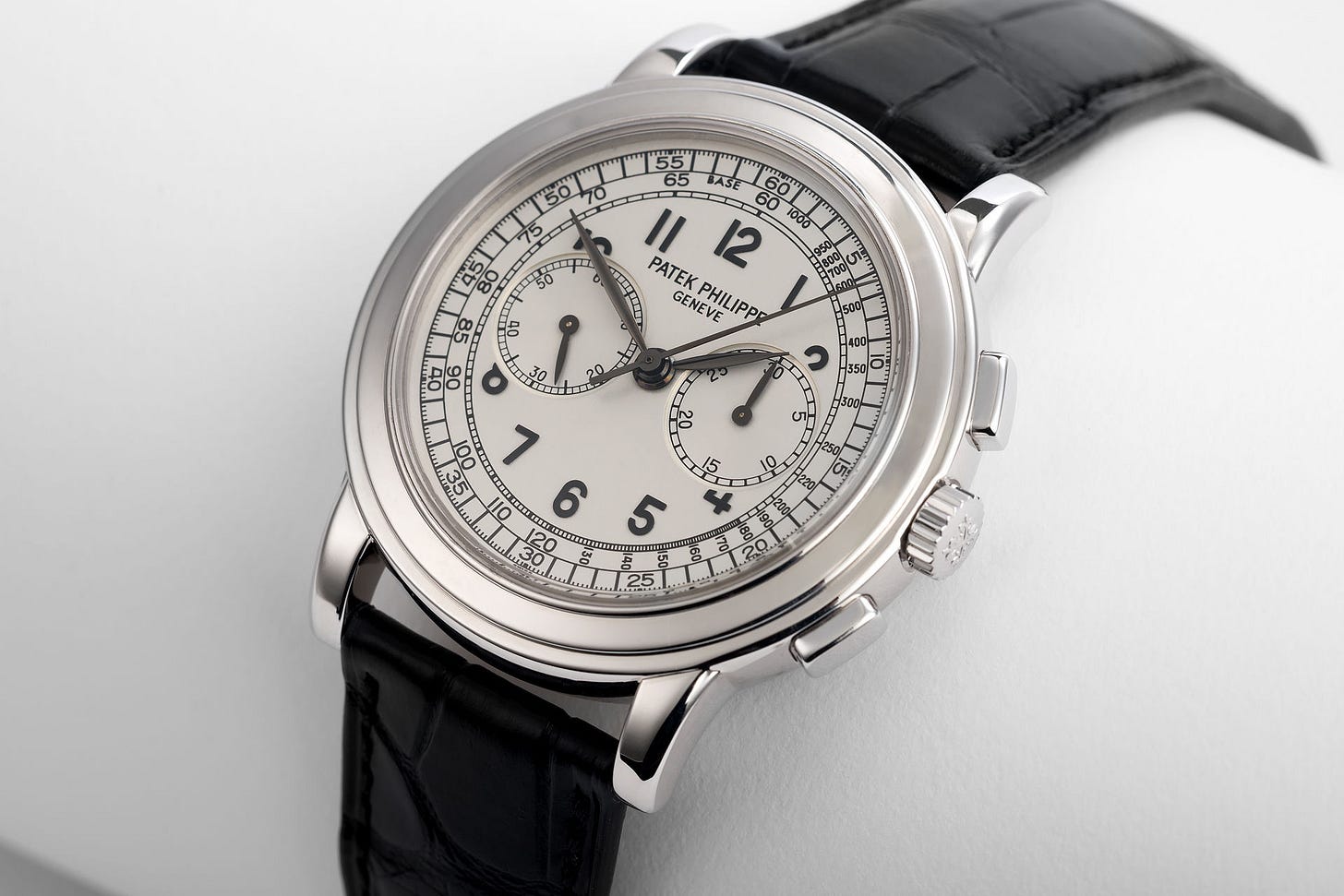The Fourth Wheel, Issue 86
What was the greatest era of chronograph watchmaking?
Hello and welcome back to The Fourth Wheel, the weekly watch newsletter that is contemplating new things. I’m always talking in vague terms about how The Fourth Wheel is going to grow and evolve, but here’s something more concrete. Let’s take a show of hands: who would be interested in reading something dedicated to vintage watches, in addition to the normal Friday newsletter - perhaps once a month, with auction analysis, insight from other experts, interesting sales listings, that sort of thing?
That’s right: I’m offering a 30 per cent discount on paid subs this month. You’ve seen it before, but just to remind you of the sales pitch:
No ads. No-one rifling through your data. No outside influence over what I write. A weekly newsletter that majors on expert analysis, journalistic investigation, honest opinion and really bad puns. If you want to have the conversation about whether content should cost money, I am here in the comments, but for the price of a pint and a packet of crisps you get to read something you won’t read anywhere else. Plus you’ll get early access and preferential treatment when I launch other ideas, and they are coming this year, I promise you that.
Here’s a little taste of what you might have missed recently:
2023 In Review
What To Expect In 2024
A Zoom Call With Jean-Claude Biver, and Ten Ways To Improve The GPHG
The Watch I Wore Most In 2023
The Best And Worst Watch Brand Websites
What was the most exciting era in chronograph watchmaking? Some people will leap right in, happy to answer such an obvious question, and tell you it was the period from 1953 to 1969 or something thereabouts. That covers us from the introduction of the Breitling Navitimer to the invention of the automatic chronograph, and encompasses the debuts of the Carrera, Daytona, Autavia, Speedmaster, Monaco, El Primero and dozens of other well-loved designs, all set against a backdrop of scintillating drama in the worlds of motorsport, aviation and spaceflight. Add on a few more years and you can include the introduction of the Valjoux 7750, quite possibly the most widely-used chronograph calibre of all time1 and a key milestone in the reintroduction of haute horlogerie in the mid to late eighties2. But no. This is not the answer3.
Wiser heads might smile at such worship of the big names, and offer up the two decades from 1923 to 1943. By this time, the chronograph wristwatch was already around, thanks to Longines, Heuer and Breitling, but in this era the world welcomed the calibres from Minerva, Venus, Valjoux, Landeron and Lemania that would become legends and power many of the aforementioned icons - not to mention high end chronographs from the likes of Breguet and Patek Philippe. These movements were beautiful, classical, hand-wound and adaptable. There is no doubt they were enormously significant; after all, it was during this era that the chronograph really took the form we recognise today, with two pushers thanks to Breitling, and Longines brought us the flyback mechanism. But for all their beauty, and notwithstanding the foundations they laid, this was not it either.
It might sound like sacrilege to some but I would argue that we have just lived through the most exciting generation of chronograph watchmaking, and on the evidence of 2023’s new watches, that purple patch shows no sign of ending. It’s easy to be wrong-footed by the mainstream obsession with heritage design that set in around a decade ago, but once you put aesthetic concerns to one side, it becomes apparent, I believe, that the last 20 years or so have given us the most advanced and ambitious chronographs ever made. There has never been a better time to be interested in stopping, starting and re-setting.
At the end of the millennium, the scope of the haute horlogerie chronograph was relatively narrow. You might see a rattrapante here or there; otherwise, the focus was on combining the chronograph with other complications. Perhaps the most daring of the 1990s was Franck Muller’s Double-Faced Chronograph, which used a long central pinion to power a multi-scale display on the back of the watch - a la Louis Vuitton’s recent collaboration with Rexhep Rexhepi. But both the indie starlets like Muller, Daniel Roth and Roger Dubuis, and the establishment brands - the likes of Vacheron Constantin, Patek Philippe, Breguet and Audemars Piguet - were comfortable with their reliance on decades-old ebauches like the 1185 Piguet or Lemania CH 27-70. The much-loved Patek 5070, for example, released in 1998, was based on the latter movement.
Handsome though that watch was, the aforementioned big names were all about to have their legs swept from under them. The launch of the Datograph by A. Lange & Sohne in 1999, housing an all-new haute horlogerie chronograph movement that combined traditional touches like a lateral clutch with improvements like the instantaneous-jumping minute counter, allied to a novel dial layout that incorporated Lange’s signature big date and dictated the construction of the movement, was in hindsight the spark that ignited a twenty-year chronograph arms race.
Keep reading with a 7-day free trial
Subscribe to The Fourth Wheel to keep reading this post and get 7 days of free access to the full post archives.




